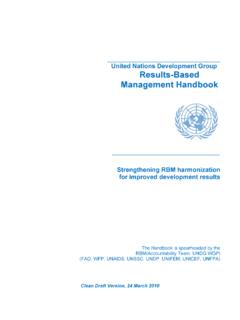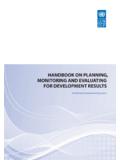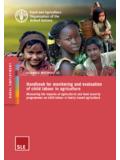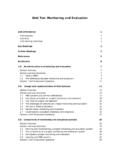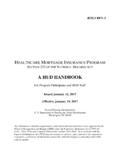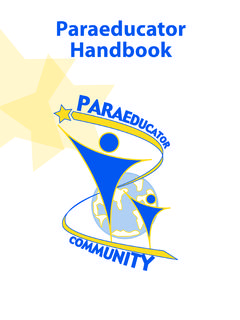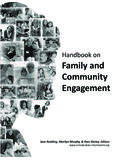Transcription of United Nations Development Group Results-Based …
1 _____ United Nations Development Group Results-Based management handbook _____ Strengthening RBM harmonization for improved Development results The handbook is spearheaded by the RBM/Accountability Team, UNDG WGPI (FAO, WFP, UNAIDS, UNSSC, UNDP, UNIFEM, UNICEF, UNFPA) Clean Draft Version, 24 March 2010 -2- Acronyms CCA Common Country Assessment CPAP Country Programme Action Plan CPD Country Programme Document CSO Civil society organization DAC Development Assistance Committee of the OECD MDG Millennium Development Goals M & E monitoring and evaluation MfDR Managing for Development results NGO Non-governmental organization PLA Participatory, learning and action OECD Organisation for Economic Co-operation and Development RRA Rural.
2 Rapid appraisal RBM Results-Based management RC Resident Coordinator SWAP Sector wide approaches TCPR Triennial comprehensive policy review of operational activities for Development UNCT United Nations Country Team UNDAF United Nations Development Assistance Framework UNEG United Nations Evaluation Group WGPI Working Group on Programming Issues -3- Table of Contents Page Purpose of the Audience of the Organization of the Part 1: Overview of What is Results-Based management ?..7 Accountability, National Ownership and The Difference between RBM and Managing for Development Basic What is a Result?..9 Getting Started: How to Define Part 2: RBM in The results Developing the results Programming Principles of CCA and Determining Your The Sources of Assumptions and The Role of Indicative Developing a Monitoring and Evaluation Part 3: RBM in Managing for Managing for UNDAF Part 4.
3 RBM in Monitoring ..22 Monitoring and Evaluation of the UNDAF as a Tools for Part 5. RBM in RBM in Measuring Achievements in Gender Equality, Advocacy and Part 6: RBM in Part 7: Using RBM for Learning, Adjusting & Annexes: -4- Annex 1: results Matrix with Outcome and Output Levels for a Maternal Health Annex 2: results Matrix with Outcome and Output Levels for a Gender Equality Annex 3: results Matrix with Outcome and Output Levels : Gender Equality Access to Resources, Goods, Services and Decision-making in the Rural Annex 4: results Matrix with Outcome and Output Levels : Prevent Hunger and Invest in Disaster Annex 5: results Matrix with Outcome and Output Levels : Tables: Table 1: Definition of Table 2: The results Table 3.
4 The results Matrix with Outcomes and Output Table 4: Table 5: Checklist for Validating Table 6: Risk Table 7: Key Challenges and Strategies to Overcome Table 8: Example of a Results-Based Figures: Figure 1: The RBM Life Cycle Figure 2: Changes Reflected in results at Different Figure 3: Elements of an Effective Results-Based Figure 4: Use results Information for Organizational Boxes: Box 1: What Kind of results Can One Expect Responding to a Humanitarian Box 2: What Does a Human-Rights based Approach (HRBA) Add to RBM?..16 Box 3: Evaluation in the UN should Box 4: Understanding the Inter-linkages and Dependence between Planning, Monitoring & -5- Introduction In the late 1990s, the UN system adopted Results-Based management (RBM) to improve the effectiveness and accountability of UN agencies.
5 This shift towards RBM was accompanied by increasing UN interagency collaboration and interaction that seek to respond to UN reform and the greater harmonization of UN programmes with national priorities. results orientation, UN reform and alignment to national priorities are typically viewed by Member States as inextricably linked to one another. Most recently, the triennial comprehensive policy review (TCPR) resolution of 2007 stressed that The purpose of reform is to make the United Nations Development system more efficient and effective in its support to developing countries to achieve the internationally agreed Development goals, on the basis of their national Development strategies, and stresses also that reform efforts should enhance organizational efficiency and achieve concrete Development results .
6 1 The commitment of the UN Development system working together as a whole to achieve results in line with national priorities is part and parcel of its shared identity and an important aspect of its legitimacy. In addition, the Paris Declaration on Aid Effectiveness, Accra Agenda for Action and the 2005 Summit Outcome document stress the alignment of policies, coherence at country level, harmonization of systems, ownership, mutual accountability and supporting countries to manage for Development results to achieve the internationally agreed Development goals, 1 TCPR resolution , paragraph 9. See also paragraph 33, which stresses, Results-Based management , accountability and transparency of the United Nations Development system are an integral part of sound management .
7 Including the Millennium Development Goals (MDGs). The UN and OECD/DAC understanding of national ownership and results orientation overlaps and complements each other. The UN approach of contributing to nationally owned results focuses on strengthening national capacities, reinforcing national leverage and widening policy choice. For the UN, RBM, when coupled with coherent UNCTs and UN programming, can improve the effectiveness with which outcomes may be pursued. Similarly, Paris Declaration principles encourage the use of national implementation systems in order to strengthen national ownership. A solid RBM system rests on what is commonly referred to as a life cycle where results are central to planning, implementation, monitoring and evaluation, reporting and ongoing decision-making.
8 By focusing on results rather than activities , RBM helps UN agencies to better articulate their vision and support for expected results and to better monitor progress using indicators, targets and baselines. Results-Based reports also help the organization(s), stakeholders and funders to better understand the impact that a given programme or project is having on the local population. Purpose of the handbook The purpose of the handbook is to provide UN agencies with common ground for supporting national programme planning and implementation efforts based on best practices in the RBM field. The handbook responds to the evolving dynamics of RBM in line with TCPR commitments while taking note of recent developments within OECD/DAC, such as the Paris Declaration and the Accra Agenda for Action.
9 Towards this objective, the handbook : -6- 1) Contributes to harmonizing and simplifying UN business practices around contribution to national efforts for achieving Development results ; 2) Provides a common framework for interagency collaboration to support countries in programme design, implementation and managing for Development results , including monitoring, evaluation and reporting; 3) Increases the quality and effectiveness of UN-supported interventions for achieving sustained results . The handbook is intended to be user-friendly and explain concepts and tools in ways that will facilitate operationalizing the use of RBM by various parts of the UN system as well as national actors, including governments at various levels, international and national NGOs, and other parties responsible for various elements of programmes at country level for achieving developmental results .
10 Key concepts, principles and terminology are presented along with different frameworks, such as the results matrix, the risk mitigation framework and the Results-Based reporting framework, with the aim of improving the application of RBM among UN agencies. Basically, the RBM handbook is a brief resource intended to provide a common denominator for the use of RBM for all UNCT members and stakeholders when developing and implementing their UNDAFs. It is not meant to be exhaustive. Web links are provided, whenever possible, to resources that provide greater detail. Audience of the handbook The handbook is addressed to all UN staff, at country, regional and headquarters levels and especially those responsible for RBM its planning, implementation, monitoring and evaluation, managing and reporting.
